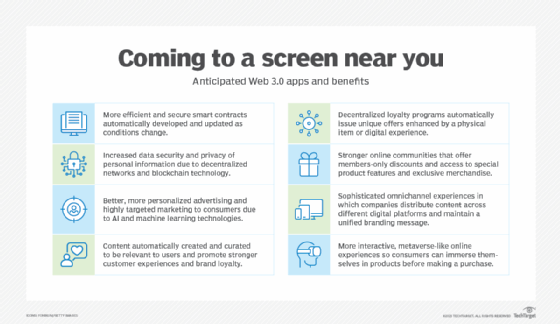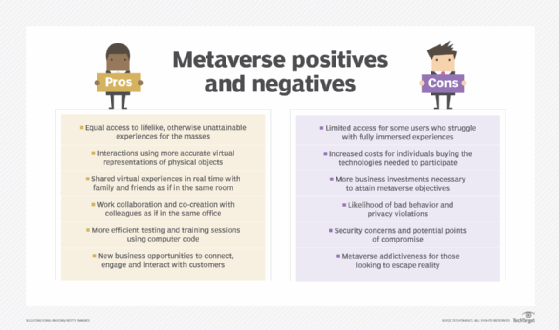8 top Web 3.0 use cases and examples
Smart contracts, automated content creation, targeted advertising, community building and metaverse-like experiences are some of the benefits from anticipated Web 3.0 applications.
Amid the cryptocurrency scandals making headlines, most people have heard about Web 3.0 whether they realize it or not. But Web 3.0 use cases reach well beyond crypto. They can range from artificial intelligence and metaverse-like applications to non-fungible tokens and decentralized finance. As a result, companies are changing the way they do business and how consumers interact with online content.
Though in its early stages, Web 3.0 is growing rapidly. Estimates see Web 3.0's market size -- currently at about $3 billion in 2023 -- approaching and surpassing $100 billion over the next 10 years. Some businesses already have rolled out their Web 3.0 applications, while others are just exploring the technology's potential for marketing, sales, contracts and other uses.
Preparing for Web 3.0
There's no question Web 3.0 will strongly impact the marketing industry, which is why companies need to begin preparing now, according to Julian Goldie, founder of advertising services Goldie Agency, who proposes businesses take the following steps:
- Invest in technology and tools that support Web 3.0 capabilities such as natural language processing, machine learning and predictive analytics.
- Develop a data privacy strategy to ensure compliance with the new data privacy regulations.
- Keep abreast of the latest developments in Web 3.0 and identify opportunities to use the technology to improve marketing strategies.
- Build a multidisciplinary team that includes experts in data science, marketing and technology to help develop and implement new strategies.
- Devise a customer-centric approach with the goal of being more transparent and secure when handling personal data and obtaining explicit consent from customers.

Ultimately, Web 3.0 will create new ways for companies to interact with their customers and prospects. To help businesses prepare for Web 3.0, here are some examples of the more common applications and their potential benefits.
This article is part of
What is Web 3.0 (Web3)? Definition, guide and history
1. Flexible and secure smart contracts
One notable Web 3.0 use case is the development of smart contracts, said Enrico Miller, CEO of social media marketing agency Benco Services. Smart contracts are enabled by blockchain technology, which creates a digital ledger to securely store information. Blockchain tracks transactions and interactions between parties. Smart contracts, Miller explained, are automatically executed and updated as conditions change, making them more efficient and secure than traditional contracts.
2. Trusted data privacy
Decentralized networks and blockchain technology can increase customer trust, said Sharon Heather, business development director at building materials supplier EasyMerchant. Customers will be more confident sharing personal information. But marketers will need to develop a strategy for data security and privacy, Heather advised, to keep that trust and continue to reap the benefits of Web 3.0.
3. Highly targeted content
Web 3.0 is driven by AI and machine learning technologies, resulting in better insights and more personalized and highly targeted advertising to consumers. "With the ability to understand user intent and preferences, Web 3.0 could enable more effective and efficient marketing campaigns," reasoned Michelle Burson, founder and president at marketing services agency MarComm. "Imagine a world where you can finally get rid of those pesky irrelevant ads and get served with only the most relevant content."
Additionally, decentralized blockchain technology enables companies to better understand their customers, said Daivat Dholakia, vice president of product and growth at regulatory lifecycle management software provider Essenvia. "By utilizing decentralized blockchain technology," he explained, "more data-driven strategies can be developed that leverage interactive visualizations and AI-powered analytics for better insights into consumer behavior. This will give marketers not only an edge in understanding what customers want, but also a higher level of accuracy when it comes to targeting consumers." But, he cautioned, companies need to make sure they're using the right algorithms to glean insight from data sets and appropriately personalize content and offers.
4. Automated content creation and curation
With Web 3.0, Burson noted, content can be created and curated automatically so it's more relevant to users, leading to better customer experiences and stronger brand loyalty.
This type of application can be especially useful in entertainment, sports and retail, said Hope Frank, CMO at metaverse tools provider Infinite Reality. "It will become increasingly important for companies to see themselves as co-creators," Frank advised. By using "Web 3.0 technology that is equipped with the required back-end tools, analytics, content moderation and user management capabilities," she explained, "[b]rands will be able to create a new level of engagement with their customers."
In e-commerce, understanding customer intent and preferences "could lead to more personalized product recommendations, search results and overall browsing experiences," Burson added.
5. Unique loyalty programs
The decentralized nature of Web 3.0 also lends itself to unique loyalty programs. Companies, for example, can add decentralized loyalty programs that automatically issue designated non-fungible tokens (NFTs) with specific point values that can be redeemed for future loyalty benefits, according to Dave Dickson, founder of no-code design tools provider PicoNFT.
High-end luxury brands may be in a sweet spot to capitalize on NFTs. "There's been a lot of hype around leveraging NFTs for marketing, especially as part of various loyalty programs," said Max Thake, co-founder of the decentralized blockchain network peaq and CMO of Web 3.0 open source developer EoT Labs. "[High-end luxury] brands are already dealing with people eager to pay the big buck for a fashion statement, and an NFT Twitter pic is very much a fashion statement these days."
For most industries, the approach should focus on delivering real value to the user beyond a picture. Add a physical item or digital experience as a tool for accessing specific discounts, groups, a physical location, or something else that will make it worthwhile for the customer.
6. Increased community building
AI and machine learning can also create stronger online communities. "Customers are looking for exclusive experiences in Web3 initiatives, and branded communities [enabled by NFTs, decentralized autonomous organizations or the metaverse] help drive connections with customers," said Dickson. These communities can offer members-only discounts as well as access to special product features and exclusive merchandise.
"In Web3, there's no marketing; there's only community building," Thake said. Web 2.0 marketing attempted to build communities with personalization, identity marketing and loyalty programs, but the effort was always top-down. Web 3.0 can enable building something people can use together, Thake said, instead of simply selling products to people. "Let them build upon what you've started," he suggested, "not just treat them as passive and obedient consumers as in Web 2.0. Embrace the community contributions and set up systems that reward those who get hands-on."
7. Better omnichannel experiences
AI and machine learning could help companies offer more sophisticated omnichannel user experiences. "Companies are better able to distribute content across different digital platforms while maintaining a unified branding message," said Lindsey Hyland, blogger at gardening tips provider Urban Organic Yield. She suggested that businesses develop their architecture by investing in AI and machine learning, build an omnichannel engagement strategy and understand how best to use decentralized technologies for customer data security and analytics.
8. Wider use of augmented reality
Augmented reality has been on the fringe of marketing and technology since German advertising agencies developed an AR campaign for a model BMW mini in 2008. When held in front of a computer's camera, the advertisement appeared on the computer screen and allowed users to interact with the ad. Today, with many consumers carrying more computing power in their smartphones versus the desktop machines of 2008, AR is becoming mainstream -- for example, the Pokémon Go craze of 2016.
Just as Web 3.0 enables more immersive, interactive, metaverse-like online experiences, it could also do the same for virtual and augmented reality in marketing, Burson surmised. The model BMW mini ad was just the beginning of an approach that could allow consumers to immerse themselves in products before making a purchase.

Expect a shift in marketing strategies
Because Web 3.0 will enable more content distribution, require a new approach to online privacy and offer increased opportunities for interactive advertising, marketers will need to adjust their strategies accordingly, said David Kemmerer, co-founder and CEO of crypto and NFT tax software provider CoinLedger.
"Web 3.0 has introduced new technological capabilities like decentralization, transparency and immutability into the marketing industry," Kemmerer said. "Every new marketing strategy in the Web 3.0 environment will focus on the needs and preferences of the customers. Innovations like the metaverse will grow as a new platform for marketing and advertising brands to a wider target audience."
To navigate the Semantic Web, marketing strategies will therefore have to be more data-driven. "They'll need to develop new skills and knowledge in technologies such as AI, big data analytics and blockchain to take advantage of the new features that Web 3.0 brings," advised Andrew Cooper, owner of vape juices company Simply E-Liquid. "[T]he concrete use cases and the impact will depend on how the technologies progress and how web users adopt them."








